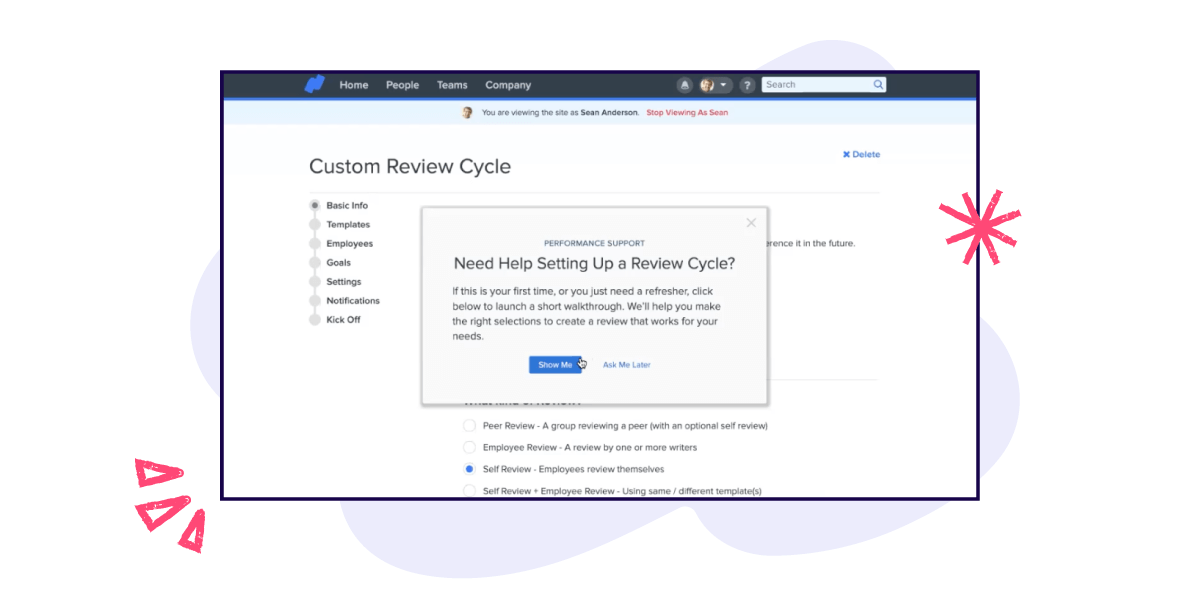Increasing education while decreasing disruption
Human resources (HR) is a field rooted in empathy. HR leaders not only keep a business running with things like recruiting, payroll, and benefits management, but also support employees to ensure a positive and productive workplace. Since these are the individuals and teams who use Namely’s platform day-in and day-out, the company aims to demonstrate that same level of empathy in their digital experience.
Namely started leveraging Pendo in an effort to help users navigate their site most efficiently, and reduce the strain on their customer service team. As Aly Grindall, content and communications specialist, put it: “The big thing we were trying to solve from day one was taking the burden off our service representatives. We wanted users to be able to self-serve right in the app—which is where we saw Pendo as our solution.”
Grindall and team first had to think about how they could give clients the knowledge they needed to complete everyday tasks, without disrupting their experience. “We’re constantly making improvements in the product, which means that a lot of things change. And we noticed that although we were creating great articles, FAQs, and how-to guides, they weren’t being utilized,” she explained. This also meant that when something changed on the site, Namely’s customer service team would get slammed with questions about why something looked a certain way or how users could complete their desired task.
The power of a good walkthrough
Grindall started building in-app walkthroughs any time the team released a product update or changed something on a page. She also connected with Namely’s service team directly to understand the most common pain points and areas they received questions about the most. This helped inform the types of guides she created and the information she needed to include in them. “[The guides] took users from Step A all the way to Step Z of how to accomplish what they wanted to accomplish,” Grindall explained.
The team also came up with a system to avoid overwhelming users with too much information. Not every guide appeared automatically, and it depended on the nature of the product update. “If it’s a completely new page with a completely new look or terminology, then we’ll surface the walkthrough automatically and kind of force clients to go through it,” said Grindall. “We’ll also include a ‘Remind me later’ button in case they aren’t in a place to view the guide at that time.”
One walkthrough that was particularly impactful related to Namely’s performance review functionality. They had recently released the ability for clients to do off-cycle performance reviews, which were reviews that occurred outside of the timeline they created when they originally implemented Namely. Grindall explained that these reviews required more set-up work from users themselves. “[For standard reviews] users would get help from an implementation representative, but for off-cycle reviews they have to figure it out by themselves,” she noted.
In order to avoid an influx of calls to the service team, Grindall used Pendo to create a walkthrough that guided users through all of the necessary set-up steps. She made sure to use clear and concise language, and also include a way for users to easily know what step they’re on and how many they have left. Grindall explained, “Since this is such an important workflow, we don’t want users to get fatigued and just click through to the end without absorbing the information.”

When evaluating the success of this particular walkthrough, the data said it all. “We saw that 67% of clients who opened the walkthrough clicked through to completion, and 98% of those clients didn’t submit a support ticket about performance reviews,” Grindall shared. “Historically, performance reviews were the subject of a lot of our support calls, so this really changed the game for us.”
Another important use case for guides is educating new employees who start at an existing Namely customer. “All of a sudden a new employee is in our system and although the rest of the company has been with us for years, this specific employee doesn’t know how to use the site,” Grindall said. “We’ve employed badges that will launch guides, so new users can access tutorials and walkthroughs at any time.” Grindall shared that the team is also starting to utilize the Pendo Resource Center to spread resources across all pages in the product. She noted, “This way, we can reach users at any point and they don’t have to be on a specific page or engaging with a specific feature in order to access help content.”
In addition to leveraging Pendo In-app Guides to alleviate the strain on the customer service team, Namely is also using Pendo Analytics to understand where users are clicking in the platform, what features they interact with, and who the most engaged users are. “Since we have such a wide breadth of employees from our clients who should and shouldn’t be able to see certain things [in Namely], we really rely on the analytics to tell us what they do in the app so we can ensure we’re surfacing the right information [to them],” Grindall explained.



